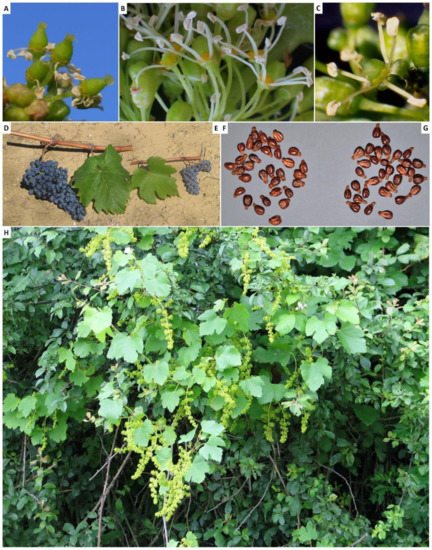
| Version | Summary | Created by | Modification | Content Size | Created at | Operation |
|---|---|---|---|---|---|---|
| 1 | Gabriella De Lorenzis | + 3223 word(s) | 3223 | 2021-05-13 04:18:46 | | | |
| 2 | Lily Guo | -709 word(s) | 2514 | 2021-06-10 03:02:27 | | | | |
| 3 | Lily Guo | Meta information modification | 2514 | 2021-06-10 08:21:09 | | |
Video Upload Options
The grapevine (Vitis vinifera L.), besides being one of the most extensively cultivated fruit trees in the world, is also a fascinating subject for evolutionary studies. The domestication process started in the Near East and the varieties obtained were successively spread and cultivated in different areas. Whether the domestication occurred only once, or whether successive domestication events occurred independently, is a highly debated mystery. Moreover, introgression events, breeding and intense trade in the Mediterranean basin have followed, in the last thousands of years, obfuscating the genetic relationships. Although a succession of genomic studies has been carried out to explore grapevine origin and different evolution models are proposed, an overview of the topic remains pending.
1. Introduction

2. The Domestication of the Grapevine in the Near East
Whether the grapevine was domesticated only once, or whether some varieties were domesticated independently, is a mystery hotly debated and different scenarios are proposed. The main hypothesis defined as the “Noah hypothesis”, so named in honour of the biblical patriarch who planted the first vineyard on Mount Ararat after the flood, proposes that grapevine domestication processes took place in a well-defined restricted area (Single-origin model). In addition, a multiple-origin hypothesis that provides for the foundation of independent lineages originating from wild progenitors spread some place along the entire distribution range has been proposed (Multi-origin model).
Genetic relationships between wild and domesticated forms can be traced by molecular analysis and several markers are widely used to show the genetic structure and domestication history of crops. One of the modern challenges in plant science is to improve the access to and use of genetic variability hidden in the genomes. In the genomic era, efficient genotyping tools should be able to cover a large part of the genome. In the last years, several authors have observed a reduction of genetic variability, confirming that the grapevine has suffered from a weak domestication bottleneck in the Near East followed by diffusion towards Europe [7,8,9]. However, studies carried out on germplasm resources collected in the Caucasus have shown an unexpected diversity and richness [5] raising some doubts about the correct geographic place of the main domestication area.
Plastid microsatellites have been used to explore the haplotype diversity from grapevine cultivars distributed from the Near East to the Mediterranean basin. Even though conclusions cannot be drawn about the domestication area from the results, the existence in the past of an intensive varietal exchange of germplasm and propagation throughout Europe have been evidenced [10]. On the other hand, Arroyo-García et al. [11], have examined the haplotype relationships under a network model in a large sampling of wild and domesticated accessions. The results supported the existence of at least two centres of domestication, one in the Near East and another in the Western Mediterranean region, confirming the involvement of several founders recruited throughout a prolonged time period. However, further studies are needed to understand the contributions made by the wild populations located in the Italian and Iberian Peninsulas, France and Greece (including the main islands of the Mediterranean basin) and to understand whether these locations have had a role of secondary domestication or were diversification centres.
3. Conclusions
References
- McGovern, P.; Jalabadze, M.; Batiuk, S.; Callahan, M.P.; Smith, K.E.; Hall, G.R.; Kvavadze, E.; Maghradze, D.; Rusishvili, N.; Bouby, L.; et al. Early Neolithic wine of Georgia in the South Caucasus. Proc. Natl. Acad. Sci. USA. 2017, 114, 10309–10318.
- This, P.; Lacombe, T.; Thomas, M.R. Historical origins and genetic diversity of wine grapes. Trends Genet. 2006, 22, 511–519.
- Caporali, E.; Spada, A.; Marziani, G.; Failla, O.; Scienza, A. The arrest of development of abortive reproductive organs in the unisexual flower of Vitis vinifera ssp. silvestris. Sex. Plant Reprod. 2003, 15, 291–300.
- McGovern, P.; Jalabadze, M.; Batiuk, S.; Callahan, M.P.; Smith, K.E.; Hall, G.R.; Kvavadze, E.; Maghradze, D.; Rusishvili, N.; Bouby, L.; et al. Early Neolithic wine of Georgia in the South Caucasus. Proc. Natl. Acad. Sci. USA. 2017, 114, 10309–10318.
- Marrano, A.; Grzeskowiak, L.; Moreno Sanz, P.; Lorenzi, S.; Prazzoli, M.L.; Arzumanov, A.; Amanova, M.; Failla, O.; Maghradze, D.; Grando, M.S. Genetic diversity and relationships in the grapevine germplasm collection from Central Asia. Vitis Geilweilerhof 2005, 54, 233–237.
- Terral, J.F.; Tabard, E.; Bouby, L.; Ivorra, S.; Pastor, T.; Figueiral, I.; Picq, S.; Chevance, J.B.; Jung, C.; Fabre, L.; et al. Evolution and history of grapevine (Vitis vinifera) under domestication: New morphometric perspectives to understand seed domestication syndrome and reveal origins of ancient European cultivars. Ann. Bot. 2010, 105, 443–455.
- Zhou, Y.; Minio, A.; Massonnet, M.; Solares, E.; Lv, Y.; Beridze, T.; Cantu, D.; Gaut, B.S. The population genetics of structural variants in grapevine domestication. Nat. Plants 2019, 5, 965–979.




